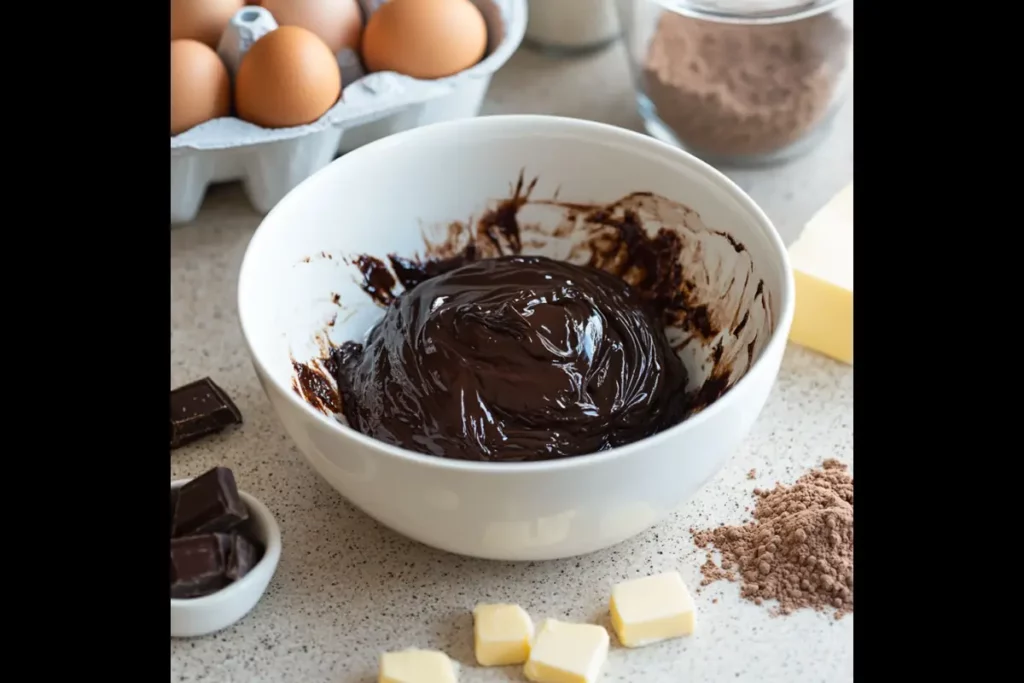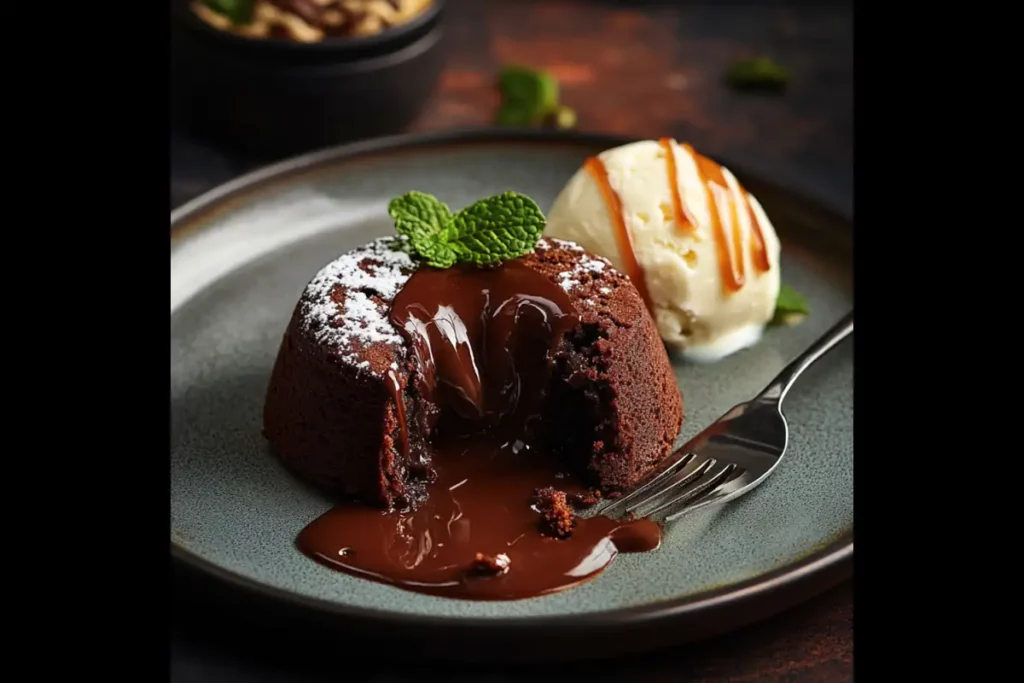Lava cake is a decadent dessert that captivates with its rich, gooey center, often described as “lava.” But have you ever wondered what actually creates that molten core? This article dives deep into the science, ingredients, and techniques behind the mesmerizing “lava” in lava cake. We’ll uncover how it’s made, explore its variations, and provide tips for crafting the perfect lava cake at home.
Table of Contents
Part 1: Introduction to Lava Cake and Its Popularity
What is a Lava Cake?
Lava cake, also known as molten chocolate cake or chocolate fondant, is a dessert that masterfully combines the best of a soufflé and a traditional chocolate cake. Its signature feature is the luscious, molten center that spills out like lava when you cut into it. This combination of textures—fluffy cake surrounding a rich, liquid core—makes it a standout treat.
Why is Lava Cake Popular Worldwide?
The popularity of lava cake isn’t just about its indulgent flavor; it’s also about the experience. Watching the warm, gooey chocolate ooze out is a feast for the eyes and an irresistible delight for dessert lovers. Originating from French cuisine, lava cake quickly gained worldwide fame due to its luxurious taste and Instagram-worthy appeal. Its simplicity in preparation and dramatic presentation make it a favorite in restaurants and kitchens alike.
The Science Behind Lava Cake’s Center
Why is the Center Called “Lava”?
The molten center of a lava cake resembles flowing lava from a volcano, giving this dessert its evocative name. This gooey center is achieved by underbaking the batter, allowing the edges to solidify into a fluffy cake texture while the middle remains liquid. This dual consistency creates a dramatic visual and textural contrast that makes the dessert truly indulgent.
The Chemistry of the Molten Core: Ingredients and Heat Interactions
The molten core forms due to the specific interactions between ingredients under heat. High-quality chocolate is the main ingredient responsible for the silky lava-like consistency. When heated, the cocoa butter in chocolate melts, creating the smooth liquid center. Meanwhile, eggs and sugar provide the structural stability around the edges, allowing the center to stay soft without collapsing.
Ingredients That Make the Lava in Lava Cakes

Core Ingredients in Lava Cake Recipes
The main ingredients that create the perfect lava cake include chocolate, butter, eggs, sugar, and a small amount of flour. Each plays a crucial role in crafting the molten core. Chocolate and butter contribute to the richness, while eggs provide structure, and sugar enhances sweetness.
Role of Chocolate in the Molten Center
The chocolate used in lava cakes is key to the liquid core. High cocoa content chocolates melt more readily, ensuring the center remains gooey. Dark chocolate, with its intense flavor, is most commonly used for its ability to provide a rich, indulgent texture.
Why Eggs and Butter Create the Perfect Texture
Eggs act as a binding agent, giving the cake its fluffy outer structure. The fat in butter, combined with the liquid consistency of melted chocolate, ensures the center stays soft and gooey even after baking. Without these ingredients, the molten core would lack its signature texture.
The Baking Process and How Lava is Formed
Temperature and Timing: The Critical Factors
The baking process is essential to creating the molten core of a lava cake. To achieve this, precise temperature control and timing are crucial. Typically, lava cakes are baked at around 425°F (218°C) for 10-12 minutes. This high heat allows the outer layer to cook into a firm, fluffy texture while leaving the center undercooked, resulting in its lava-like flow.
The delicate balance between time and temperature can make or break a lava cake. Baking it even a minute too long can overcook the center, turning it into a dense cake. Conversely, removing it too soon may leave the structure too weak, causing the cake to collapse.
Underbaking: The Secret to the Gooey Center
Underbaking is the key to creating the gooey center that makes a lava cake stand out. By intentionally leaving the batter in its liquid state in the middle, the “lava” effect is achieved. The higher fat content in chocolate and butter contributes to the stability of the molten core, ensuring that it doesn’t completely harden during baking.
To test the cake, gently press the top. A properly baked lava cake will have a slightly firm surface that springs back while feeling soft in the middle. Avoid opening the oven too early, as this can cause uneven baking and deflation.
For more tips on perfect baking techniques, you might find our recipe for precise timing in desserts helpful.
Variations in Lava Cake Recipes
Different Types of Lava Cakes: White Chocolate, Caramel, and More
While traditional lava cakes use dark chocolate, creative variations can introduce new flavors to this classic dessert. White chocolate lava cakes offer a sweeter, milder taste, while caramel-based lava cakes add a rich, buttery depth. Some recipes even incorporate fruit purées or matcha for unique flavor twists.
These variations still rely on the core baking principles of underbaking the center while firming up the edges. By swapping the type of chocolate or adding fillings like peanut butter or Nutella, you can personalize your lava cake to suit any palate.
Vegan and Gluten-Free Options
For those with dietary restrictions, vegan and gluten-free versions of lava cake are possible with simple ingredient swaps. Plant-based butter and egg substitutes like flaxseed or aquafaba can replace traditional dairy and eggs. Gluten-free flour blends ensure the structure remains intact without compromising texture.
Adapting lava cakes to meet dietary needs does not detract from their indulgent nature. The gooey center, a hallmark of the dessert, can still be achieved with these adjustments, making it inclusive for a wider audience.
For more creative recipe ideas, check out our collection of innovative dessert recipes.
FAQs About Lava Cake’s Lava
Is the Lava in Lava Cake Safe to Eat?
Yes, the lava in lava cake is safe to eat when prepared correctly. The gooey center is not raw but partially cooked due to the high temperatures during baking. The ingredients, such as eggs, sugar, and chocolate, undergo sufficient heat exposure to eliminate harmful bacteria. Moreover, the molten texture is achieved through careful timing rather than undercooking.
However, it’s essential to use high-quality, fresh ingredients when making lava cake at home. Using pasteurized eggs can provide an extra layer of safety. For those curious about what the lava in lava cake is made of, the answer lies in the perfect blend of melted chocolate, butter, and lightly cooked eggs.
Can You Reheat Lava Cake Without Losing the Lava?
Reheating lava cake can be tricky because the molten center may harden if not done carefully. To maintain the gooey center, warm the cake gently in the microwave for 10-15 seconds. Alternatively, you can heat it in the oven at a low temperature for a few minutes. Be cautious not to overheat, as this can overcook the center and ruin the lava effect.
For best results, enjoy the lava cake fresh out of the oven. Its unique texture and molten core are best experienced immediately after baking.
Tips for Making the Perfect Lava Cake at Home

Essential Equipment for Baking Lava Cake
The right tools can make a significant difference in achieving a perfect lava cake. Individual ramekins are ideal for ensuring even baking and easy portion control. A digital kitchen scale helps measure ingredients accurately, which is crucial for consistent results. Additionally, non-stick spray or butter and cocoa powder can be used to prepare the ramekins, preventing the cake from sticking.
An oven thermometer is also a handy tool to verify that your oven reaches the correct temperature. Consistency in heat is critical to creating the perfect outer texture while preserving the molten core.
Common Mistakes to Avoid
Several common mistakes can ruin a lava cake, but they are easy to avoid with careful attention to detail. Overmixing the batter can introduce too much air, leading to a spongy rather than gooey texture. Similarly, overbaking can turn the molten center into a dense, dry filling.
Underpreparing the ramekins is another frequent issue. If the cake sticks to the sides, the molten center may spill out before serving. Ensuring the ramekins are well-greased and dusted with cocoa powder prevents this problem.
Lastly, using low-quality chocolate can affect the flavor and texture of the lava. Always opt for premium chocolate with a high cocoa percentage for the best results.
For more tips and tricks, you can explore other dessert techniques on SimplyYummy, such as how to use precision timing in baking recipes.
Part 8: FAQs About Lava Cake
What Makes Lava Cake Different from a Chocolate Cake?
Lava cake stands out from a traditional chocolate cake because of its texture. While chocolate cake bakes until fully set, lava cake remains partially underbaked to create its gooey center. This molten middle produces the iconic “lava” effect that dessert lovers adore.
If you wonder what is the lava in lava cake made of, the answer lies in the melted chocolate, butter, and lightly cooked eggs. These ingredients combine to form the flowing consistency at the core while keeping the edges firm.
Is Lava Cake Fully Cooked?
Lava cake doesn’t fully cook by design. The center stays in a semi-liquid state because it doesn’t reach the same temperature as the outer layer. However, using fresh and safe ingredients ensures the molten center is completely safe to eat. The gooey middle makes lava cake unique and irresistible.
What is the Nutritional Value of Lava Cake?
Lava cakes pack a rich flavor but also come with a high calorie count. Ingredients like butter, chocolate, and eggs contribute significant amounts of fat and sugar. You can enjoy lava cake as an occasional treat or modify it with lower-calorie options to suit your dietary needs.
Part 9: The Final Word on Lava Cake
Why is Lava Cake a Timeless Dessert?
Lava cake captivates dessert lovers worldwide with its rich flavor and dramatic presentation. The firm, fluffy exterior contrasts perfectly with the flowing chocolate center, creating an unforgettable experience. Its simple ingredients and easy preparation ensure its place as a favorite in homes and fine dining alike.
When people ask, what is the lava in lava cake made of, the answer highlights the magic of chocolate, butter, and eggs. These ingredients, combined with precise baking, create the gooey core that defines the dessert.
Tips for Enjoying Lava Cake to the Fullest
You can enjoy lava cake at its best by serving it warm and fresh from the oven. Add a scoop of vanilla ice cream or whipped cream to enhance the experience. For a bit of texture, sprinkle crushed nuts or drizzle caramel sauce on top.
You can also experiment with flavors like orange zest or espresso powder to elevate the taste. Lava cake offers endless possibilities, so let your creativity shine as you customize this classic dessert.
For more dessert ideas and creative recipes, check out SimplyYummy’s inspiring collection of sweet treats.lection of dessert ideas. Let us know if you’d like to explore further!

